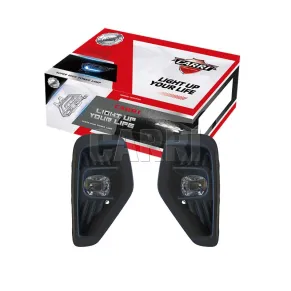Fog Lights: Uses, Types, Benefits & More
Aug. 07, 2025
Fog, heavy rains, sandstorms and other poor weather conditions make it difficult to drive. These conditions reduce visibility and make it harder for drivers to navigate around. Conventional headlights are not effective enough in uncertain weather conditions and can at times lead to accidents and other hazards. To solve this problem, cars now come equipped with fog lights.
Fog lights are designed to improve visibility when driving in bad weather. These lights shine directly on the road and reduce glare, helping drivers navigate challenging conditions more safely.
Dive in to learn more about automotive fog lights and their uses.
Fog Lights Explained
Fog lights are an essential car feature in the UAE, especially for drivers who often encounter difficult weather conditions. Typically located lower on the vehicle, these lights avoid reflecting off the fog in front of the vehicle and reduce glare. It illuminates the vehicle’s path by projecting a wide, bar-shaped beam that stays low on the road. This reduces the amount of scattered light.
Here is everything you need to know about vehicle fog lights, their function, types and more.
What is the Function of a Fog Light? The purpose of these specially designed lights is to increase visibility by illuminating the road in low-visibility conditions. Some common fog light uses are:
Enhance Road Visibility
It enhances visibility by providing a focused beam that lights up the road surface, obstacles, curbs and lane markings. It does so without causing excessive reflection from the fog, making it easier for other drivers to drive.
Reduce Glare
A car’s high beam scatters lights and creates a glare while driving in foggy conditions. Whereas, fog lights are designed to cut through the fog or mist by projecting a wide and low beam that directly hits the road. Since the lights are located below the headlights, it does not reflect from the fog.
Improved Driver Reaction Time
It becomes easier for drivers to spot hazards or obstacles in poor weather conditions with the help of fog lights. This gives them the time to react accordingly and ensure safety.

Additional Benefits
It adds an aesthetic appeal and a sporty look to the vehicle.
Does not reflect and blind the drivers coming from the opposite direction.
Fog lamps located on the rear end make the vehicle more visible to drivers behind the car.
When to use Fog Lights? Fog lights should be used in all low visibility conditions due to poor weather for a safer driving experience. Some instances where using fog lights becomes a necessity are as follows.
Heavy Fog
As the name suggests, fog lights are designed to be used in heavy fog conditions where visibility is significantly reduced.
Heavy Rain or Snow
Heavy rain or snowfall can also affect the visibility of drivers. These lights can be helpful in such conditions as they cut through the precipitation and illuminate the pathway without causing a reflection. It is crucial to prepare the car for the rainy season or fog by ensuring that the fog lights are fully functional.
Sandstorms
Fog lights can be used in sand storms or dust storms to cut through airborne particles and improve visibility for drivers – resulting in an easier and safer drive.
Nighttime in Remote Areas
Remote areas with no street lights can also be hard to navigate. Headlights alone are not enough in most cases as they cause glare and reflections. This is why fog lights can come in handy in such conditions. They provide additional lighting that helps improve visibility and ensures safer driving at night.
Types of Fog Lights
There are various types of fog lights available in the market. However, LED lights and halogen lights are the two most common types.
Halogen Lights
Halogen lights are the most commonly used type of headlights in cars. These lights are an old technology and have been used in vehicles for decades. Halogen lights are easy to install and replace as they are affordable and widely available. It uses a filament heated by an electric current to emit light.
However, halogen lights have a shorter lifespan as compared to LEDs and consume more energy. Additionally, the light emitted from halogen lights has a lower brightness when compared to other options.
LED Lights
LED fog lights are used in most modern vehicles as they emit bright light while using minimal energy. The beam is also extremely focused giving a clearer view of the path. This high-efficiency light has a longer lifespan as compared to halogen bulbs and is available in different colour options. Drivers can choose either white or yellow light depending on their preference. In the case of driving in off-road terrains during fog, drivers must use LED off-road lights along with fog lights to enhance safety.
However, LED lights are typically on the expensive side compared to halogen bulbs and are comparatively difficult to install and replace.
FAQs
What is the Purpose of Fog Lights?
These specialized lights are designed for foggy or other low-visibility conditions, such as dust or smoke. These lights penetrate in such conditions and create a clearer view of the road.
How do Fog Lights Work?
Fog lights reflect a horizontal band of light at the front of the vehicle. The light beam does not project upwards like normal lights because of the special built-in shield.
Do Fog Lights Help in the Rain?
Yes, car fog lights are designed to improve visibility in most weather conditions including rain. These lights are located below the headlights which allows them to cut through rain, dust, fog and more.
How to Turn on Fog Lights?
The location of the fog light switch can differ depending on the vehicle. However, you must look for the fog light symbol either on the indicator stick or the panel under the AC vent. Use these buttons to turn on the lights when needed.
For drivers who regularly come across harsh weather conditions, fog lights are a valuable asset. These lights enhance safety by improving visibility when driving in fog, rain or sandstorms. Whichever type of fog lights the vehicle might have, it is important to conduct regular car maintenance to ensure that they are fully functional. These lights make all the difference when trying to navigate low-light and low-visibility conditions.
135
0
0


Comments
All Comments (0)